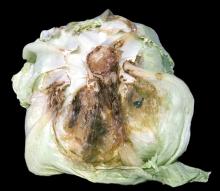Cause Rhizoctonia solani, a fungus. The disease is widespread, occurring most often on muck soil. It commonly attacks 'Big Boston' types of head lettuce.
Symptoms The disease appears as heads approach maturity. Necrotic spots appear on stems and midribs of lower leaves and may enlarge over the entire stem. A brown exudate appears on the surface of the spots, and infection continues to produce sunken brown spots. The fungus may advance through the leaf blade until the entire head is destroyed. Brown sclerotia develop near leaf axils, and the fungus may produce a noticeable network of growth around the head. The head becomes slimy and dries to a blackened mummy. Bacterial soft rot often follows bottom rot invasion.
Cultural control
- Use well-drained soil or raised beds.
- Rotate with nonsusceptible crops such as sweet corn or onions if practical.
Chemical control
- Quadris Flowable (Group 11) at 0.4 to 0.8 oz/1,000 row feet applied in a 7-inch or less band either in-furrow at planting or as a directed spray at cultivation. 4-hr reentry.
- Rovral 4 Flowable (Group 2) at 1.5 to 2 pints/A in at least 40 gal water by ground. Apply at the three-leaf stage of growth and again 10 days later. A third application can be made 10 days later if disease pressure persists. Do not apply within 14 days of harvest. Do not cultivate after application. 24-hr reentry.
Biological control
- Bexfond at 7 to 14 fl oz/A for soil applications via drenches, in-furrow applications, drip irrigation, or sprays followed by irrigation. Reapply 3 to 4 weeks after planting. Studies in Germany show a significant reduction in disease severity in lettuce. 4-hr reentry. O
- Double Nickel LC at 1 to 2 quarts/A as a banded soil spray or drench on 4- to 6-week intervals or at 0.5 to 4.5 pints/A on 2- to 4-week intervals. Can be applied the day of harvest. 4-hr reentry. O
Reference Chowdhury, S.P., Dietel, K., Randler, M., Schmid, M., Junge, H., Borriss, R., Hartmann, A., and Grosch, R. 2013. Effects of Bacillus amyloliquefaciens FZB42 on lettuce growth and health under pathogen pressure and its impact on the rhizosphere bacterial community. PLoS ONE 8(7):e68818. doi:10.1371/journal.pone.0068818.

